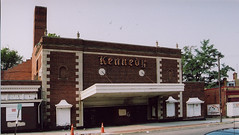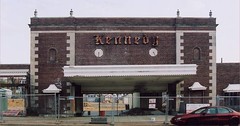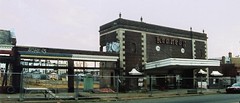Government facilities planning can accomplish multiple objectives

The Kennedy Theater in better days.
----------------
Update: 8/9/2007. One of the examples I have written about in the past was the proposal to move the DC Police Department to a location away from other DC Government agencies and the Courts, with reduced access to transportation assets of all sorts. Apparently, the DC Government decided not to go through with the lease. See "D.C. Police Offices' Move Is Called Off," subtitled "Plan Is Too Costly, City Official Says," from today's Post.
See the previous blog entry "How the Growth Machine promotes DC intra-city sprawl."
---------------
I have been writing about what I call intra-city sprawl (Stuart Sirota calls this "inward suburbanization") when local planning and government facilities planning disconnects land use decisions from the principles of compact development, concentrating uses, and mixed use and multiple primary uses (Jane Jacobs).
I frequently counter with the example of Arlington County, which has some facilities that are mixed use, for example the Thomas Jefferson Community Center -- with an exhibit hall/track, theater, and other facilities -- combined with a middle school, and the Shirlington Library which is combined with the Signature Theater.
(I've written about other examples in the past from Austin, Texas and San Diego, among others.)
Arlington is doing it again, with the Westover Library and School. See "Exciting Chapter In Long Saga of Westover Library," subtitled "Project Set for 2009 Opening," from the Arlington-Alexandria Extra section of the Post.
2. Baltimore provides another example, which cries out to me, given all the special use senior wellness centers being constructed in DC, facilities that are closed in the evening and overnight. See "From shabby to special in Pikesville," is about the opening of a combined senior center and library. From the article:
The library, which grew from 18,000 square feet to 21,500 square feet, was the third-busiest in Baltimore County last year, with more that 530,000 visitors, according to a library spokesman.With the renovations, the library can meet the space and technological needs of its customers, and is now one of the larger libraries in the county, said Fish...
First operating out of a store front on Reisterstown Road in 1979, the center moved to its current location above the library in 1982 and now has more than 1,200 members. The biggest addition to the senior center will be the fitness center. The room, which looks over Reisterstown Road and into the library, will be the seventh senior fitness center in Baltimore County.

DC's Office on Aging bought and destroyed the Kennedy Theater, leaving only the facade, to construct a single purpose senior wellness facility. How about combining senior wellness functions with recreation centers or other facilities? (Photos by Peter Sefton.)

Also see:
-- Who can you turn to when the most active, aggressive destroyers of the city's livable places are DC Government agencies?
Labels: capital improvements planning, education, libraries, public assets



0 Comments:
Post a Comment
<< Home